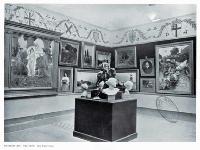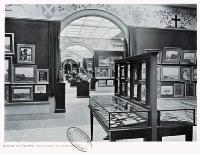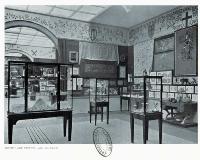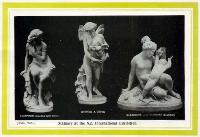Art at the Exhibition
- The Exhibition art gallery played host to an extensive collection of artworks from Britain as well as some art from Australia and New Zealand.
- Many of these works were purchased during the Exhibition and some now belong to the Christchurch Art Gallery.
Introduction
The art exhibition proved hugely popular, attracting one and a half million visitors. "To a great many New Zealanders the British Art display… was the most attractive section of the Exhibition".1 It was gratifying, the Press enthused, that New Zealanders should have the opportunity to see the largest art exhibit ever shown by the Mother Country at an international exhibition.
The gallery was open 6 days a week from 10am - 5:30pm and again from 7:30pm - 10pm. The entrance fee on Monday-Wednesday was sixpence and on Fridays a shilling, while Thursday and Saturday were free.
The British Art Exhibition
The exhibition of British art at the International Exhibition was the first major collection of non-colonial art seen in New Zealand. The collection "was one of the most perfect … ever sent from Great Britain, and by far the finest ever shown in a British colony".2
The works were selected by Sir Isadore Spielmann, assisted by Sir Edward Poynter, president of the Royal Academy, and the presidents of various British art societies. Their selections represented the development of British art but were generally conservative: 567 artists were included but modernism was poorly served and many of the most famous names, including Whistler, Sickert, and Sargent, were missing.
The art works exhibited were mostly oil paintings (5 galleries) and watercolours (1 and a half galleries) but there were also sculptures, miniatures, architectural drawings, black-and-white drawings, and etchings. The range of subjects included allegorical, historical and mythological works, genre or "subject" paintings, decorative figures, landscapes and seascapes, portraits, animal paintings, and a few impressionistic works.
Arts and Crafts
An important Arts and Crafts section, with 690 works by 171 artists, was put together by Walter Crane and Alfred Longden. This section included furniture and furnishings, textiles, jewellery, metalwork, book bindings, glass, ceramics, mosaics, wood carvings, silver and illuminations. Nearly half the exhibitors were women, including the only New Zealander, Alice Beatrice Waymouth of Christchurch who exhibited art jewellery work and sold 8 pieces.
The New Zealand Government paid for the collection of the works, packing, insurance, transportation and the cost of installation, a total of £7126.
New Zealand and Australian art exhibition
The exhibition of colonial art was very small and of minor consequence, compared with the British exhibit. It took up only 3 of the 12 galleries in the Art Gallery building, no reviews appeared in the local press, and it is hardly mentioned in official publications.
The 355 works on display were selected by local art societies and the New Zealand Fine Arts Academy, with the largest number coming from Canterbury. There was no attempt to trace the development of Australasian art; only modern works were included. Few major artists were represented (among those missing were John Gully, John Barr Clark Hoyte, Charles Frederick Goldie, James McLauchlan Nairn and Frances Mary Hodgkins), but there were paintings by Sydney Lough Thompson, George Edmund Butler, Raymond Francis McIntyre and Charles Worsley, who also sold his paintings of New Zealand scenery from a shop just outside the Art Gallery entrance.
Among the Australian artists exhibited were Hans Heysen, Jane Sutherland, Will Ashton, William Lister and Elizabeth Armstrong.
Colonial artists were, however, represented elsewhere in the Exhibition, in some provincial and state courts. In the West Coast Court Charles Blomfield and William Fox among others were exhibited. Artworks also featured in the North Canterbury and Victoria Courts. The Department of Tourist and Health Resorts Court had displayed romantic landscapes designed to promote tourism. The foyers and corridors of the Main Building were lavishly decorated with sculptures.
The enthusiasm of the public for the British Art Exhibit and the purchases of British works made by local art societies had a negative effect on colonial art and artists. Whereas the New Zealand Academy of Fine Arts had previously bought only local art works, it now spread its funds over a much wider range. This reduced the money available to purchase works from New Zealand artists. Not only did the British Art Exhibit leave its mark on "most of our public collections … it [was] British art that New Zealanders most enthusiastically supported well into the twentieth century."3
Sales
New Zealanders bought around £12,000 worth of paintings, and Australians another £5000, the average prices being £186 for an oil and £55 for a watercolour. The most popular works were landscapes and genre paintings. A further £9660 was spent by art societies in Australia and New Zealand. Nearly half the arts and crafts exhibits (321 pieces) were also sold, metalwork and jewellery being the most popular purchases. The commissions earned on the sales amounted to £1710.
The works purchased by the Canterbury Society of Arts formed the foundation collection of the Robert McDougall Art Gallery when it was opened in 1932.
Among the works purchased by the Canterbury Society of Arts which are now in the collection of the Christchurch Art Gallery are:
- Sunlight through the Leaves, by Lucy Kemp-Welch
- Winter in the Highlands, by George Houston
- Teresina, by Lord Frederic Leighton
- The Lass of Dee, by Charles Hartwell
- The Wizard's Garden, by G.D. Leslie
- The Age of Innocence, by Alfred Drury
- Doubts, by Henrietta Rae
- Summer Days, by Mabel Hankey
All of these works can be seen in the Christchurch Art Gallery Te Puna O Waiwhetu's Collection Online
![]()
Related photos
Sources
- Calhoun, A. "More than mere embroidery! Women, the Arts and Crafts and the Exhibition". In J.M. Thomson (Ed.), Farewell colonialism : the New Zealand International Exhibition, Christchurch, 1906-07
- Cowan, J. Official record of the New Zealand International Exhibition of Arts and Industries held at Christchurch, 1906-7. Section X, page 267-285
- Tyler, L. "Art for Empire : Paintings in the British Art Exhibit". In J.M. Thomson (Ed.), Farewell colonialism : the New Zealand International Exhibition, Christchurch, 1906-07
- Vial, J. "New Zealand and Australian art". In J.M. Thomson (Ed.), Farewell colonialism : the New Zealand International Exhibition, Christchurch, 1906-07
Related links
Biographies of New Zealand artists
- John Gully in the Dictionary of New Zealand Biography
- John Barr Clark Hoyte in the Dictionary of New Zealand Biography
- Charles Frederick Goldie in the Dictionary of New Zealand Biography
- James McLauchlan Nairn in the Dictionary of New Zealand Biography
- Frances Mary Hodgkins in the Dictionary of New Zealand Biography
- Sydney Lough Thompson in the Dictionary of New Zealand Biography
- George Edmund Butler in the Dictionary of New Zealand Biography
- Raymond Francis McIntyre in the Dictionary of New Zealand Biography
- Charles Blomfield in the Dictionary of New Zealand Biography
- William Fox in the Dictionary of New Zealand Biography
Footnotes
- [1] "The Art Gallery : its great success", The Canterbury Times, 17 April 1907, page 26
- [2] "The Art Gallery : a magnificent collection", The Canterbury Times, 7 November 1906, page 28
- [3] Tyler, L. "Art for Empire : Paintings in the British Art Exhibit". In J.M. Thomson (Ed.), Farewell colonialism, page 104










